No piece on puttanesca is complete without a knowing wink to the literal translation of the name: “tart’s spaghetti”, as Delia rather coyly has it, or whore’s pasta, as it is more commonly known. Usually this is just an excuse for a double entendre about the dish’s coarse, fiery flavours. Whatever the truth about its origins and myths, I think the most oft-quoted story, that it was a cheap dish the working girls of Naples could knock up from the cupboard between tricks, is a useful one to bear in mind.
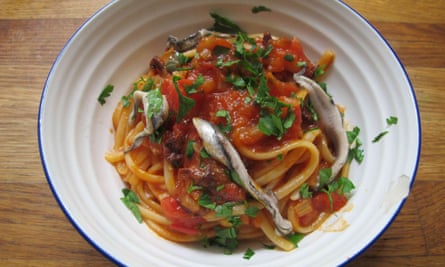
Whenever time and raw materials are short, whether that is because you’ve been working late (whatever your profession), or you’ve just been too lazy/hungover to go the shops, pasta is usually the answer. Puttanesca is the supreme example – more satisfyingly savoury than a simple aglio e olio, but less work than a carbonara, it is a handy one to master.
Born (allegedly) from a post-war enthusiasm for tomato-based sauces, the other ingredients are simple: olives, capers, anchovies, garlic and chilli. Even these are interchangeable; in Naples, apparently, they don’t tend to use the anchovies, while the Accademia Italiana della Cucina omits the chilli. But, as so often with Italian recipes, no two cooks put them together in the same way – and, generally speaking, everyone else is doing it wrong. So just how do you do it right?
Tomatoes

These prove to be the backbone of the dish, to my slight surprise – I’d never really thought of a puttanesca as a tomato-based sauce, more of a loose amalgamation of ingredients of roughly equal importance. Angela Hartnett and Italian-American celebrity chef Lidia Bastianich use tinned tomatoes; Valentina Sforza, the author of 500 Pasta Dishes, goes for passata; The Geometry of Pasta makes a light tomato sauce and combines it with cherry tomatoes; Rachel Roddy of the Roman food blog Rachel Eats mixes ripe tomatoes and puree; while The River Cafe Classic Italian goes down the fresh-only route with plum tomatoes, as does Gennaro Contaldo with cherry tomatoes.
Fresh tomatoes seem contrary to the spirit of this dish, especially when transplanted to an autumnal Britain; unless you simmer them long and slow, as the River Cafe suggests, they’ll never pack enough flavour. Roddy suggests an alternative of tinned tomatoes and puree, but I prefer the smoother consistency of passata – plus even the best tinned tomatoes can be watery unless they’re cooked down, and this seems to be less of a problem with the passata. So, for both flavour and texture, passata and puree win the day.
Fire
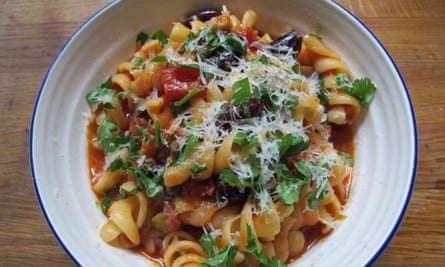
Hartnett puts onion in her sauce, while most other people use just garlic, in varying quantities – Sforza only infuses the oil with it before whipping it out, while Bastianich sticks in a clove a person, and most recipes go for roughly half that. Although it shouldn’t be overpowering, it’s got some strong competition in the flavour department, and I can’t detect it at all in Sforza’s dish. Garlic has a fiery quality of its own which works well with the chilli, so I’m going to err on the generous side. The milder onion, however, just gets lost, so I’m going to tell it to do just that.
Most versions of this dish also include chilli, usually dried – whether that is crumbled whole peppers, as in the River Cafe and Sforza versions, or the chilli flakes used by Hartnett, Bastianich and The Geometry of Pasta – but sometimes fresh, as in Contaldo and Anna Del Conte’s recipes. I prefer the fiercer heat of the dried variety, which, in any case, seem more appropriate to the store-cupboard theme.
Salt
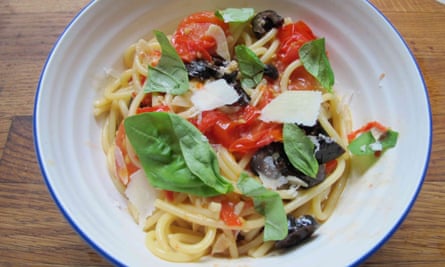
The heat of the garlic and chilli is countered by umami in the form of anchovies, olives and capers. Anchovies, whatever the Neapolitans might think, are a must, and not just any sort either. Hartnett uses vinegary marinated fish rather than the salted kind and, pretty as they look, I really miss the rich savouriness that perfumes the other dishes. They should melt into the sauce, rather than supplying its garnish, leaving little trace of fishiness but an intense flavour of the sea.
Vegetarians should note, you can go some way towards this with good black olives (Bastianich’s brighter green ones taste all wrong) and capers, preferably the salted rather than the pickled kind. But, as these don’t dissolve, you shouldn’t overdo it; The Geometry of Pasta’s olive and caper-heavy dish had me reaching for the water.
The herbs
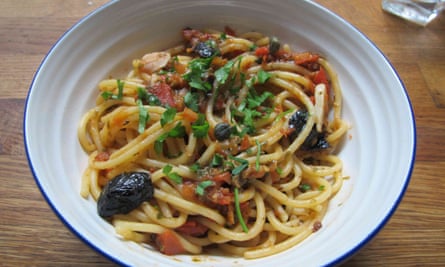
The River Cafe and Sforza add dried oregano to their sauces, while almost everyone else relies on fresh flat-leaf parsley alone – Contaldo suggests basil instead. I don’t think it needs either; though the sweetness of the basil makes an interesting change, I find the oregano too strong, and neither marry as well with the other flavours as the peppery parsley. If fresh parsley doesn’t tend to lurk in your salad drawer, or on your windowsill, then by all means substitute a tiny pinch of dried oregano at the same time as the chilli, or indeed leave this a herb-free zone.
Extras
Contaldo finishes his dish with parmesan and Bastianich pecorino, but, whatever the rules about cheese and fish, I think the sauce should have enough savoury oomph to make any such additions completely unnecessary. Sforza adds white wine to the sauce and the River Cafe finishes the dish with a drizzle of lemon juice. Both supply acidity, but the tomatoes have quite enough of that as it is, and adding extra cuts through the richness of the other flavours in a way I don’t particularly like. Feel free to squeeze in a little lemon juice if you disagree.
Pasta
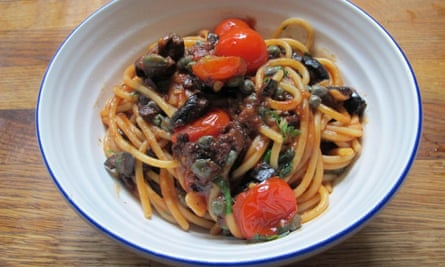
Hartnett suggests swapping in linguine, which works fine, and Bastianich fusilli, which, while it’s better at trapping bits of caper and olive, doesn’t hold the tomato sauce as obligingly. If that’s what you’ve got in the cupboard, by all means use it – this isn’t a dish that ought to stand on ceremony – but for preference, I’d stick with spaghetti.
(Serves 2)
160g spaghetti
3 tbsp good olive oil
2 garlic cloves, very thinly sliced
4 anchovies, rinsed if packed in salt, roughly chopped
½ tsp chilli flakes
50g good-quality black olives, stoned and roughly chopped
1 tbsp brined capers, rinsed if packed in salt, roughly chopped
100ml passata
2 tbsp tomato puree
Small bunch of flat-leaf parsley, roughly chopped
Put a large pan of well-salted water on to boil. When bubbling, add the pasta, stir, and cook for 8-10 minutes according to packet instructions, until very slightly underdone.
Heat the oil in a frying pan over a medium-low heat. Cook the garlic very gently until just beginning to colour, then add the anchovies and stir to dissolve. Stir in the chilli flakes, then the olives and capers, and turn up the heat slightly until you can hear them sizzling.
Add the passata and puree and stir well, then simmer vigorously for about five minutes, or until the pasta is done. Check the seasoning.
Drain the pasta well, then tip into the frying pan and toss well to combine. Divide between bowls and top with the parsley.
Pasta alla puttanesca: how do you make yours – anchovies or veggie, fiery or richly tomatoey, or piled with cheese? And please, feel free to share the other creations you knock up when the fridge is bare …
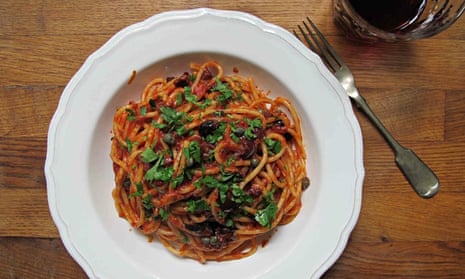



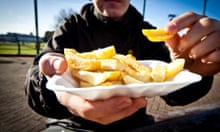

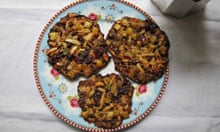
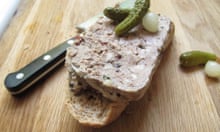

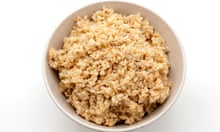
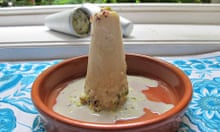
Comments (…)
Sign in or create your Guardian account to join the discussion